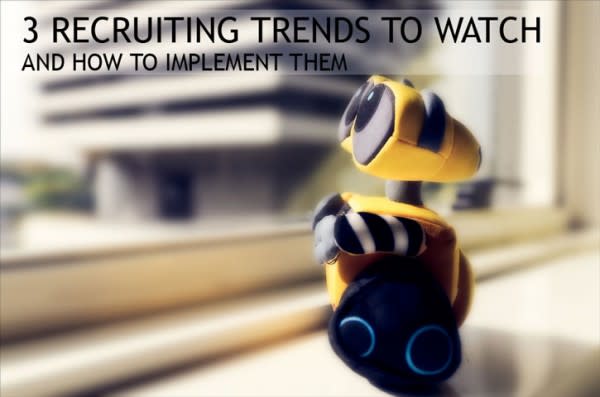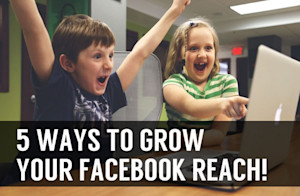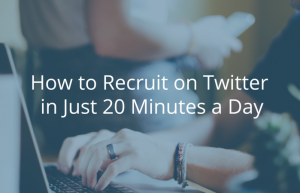
3 Recruiting Trends to Watch
The future is now.
Recruiting technologies abound, and social recruiting is on the rise. Everywhere you look, there's another hot new hiring trend emerging. Last week, we shared an article that explained how to decide which of these trends to adopt.
This week's article explores three of the most useful new recruiting trends, explains why they matter, and how you can implement them into your own recruitment strategy (no matter what size your budget!)
The Resume is Being Overshadowed by Data
Resumes have a lot of flaws...
For one, they are inaccurate.
“58% of hiring managers said they’ve caught a lie on a resume!” (CareerBuilder Survey) - Click to Tweet
Resumes do not provide insight into an applicant's soft skills. According to a study by the American Management Association of over 2, 115 managers, “communication, creativity, critical thinking, and collaboration are important to employees' success.”
The resume does not provide insight into any such skills.
Oh, and to top it all off, one of the main pieces of information that resumes do provide may not actually have anything to do with job performance! That’s right, I’m talking about education.
Pegged Software actually found that there was “zero statistically significant correlation between a college degree or a master's degree and success as a software developer." (Source: NPR Planet Money)
These are just some of the reasons that companies are turning to people-analytics as a way of replacing old school, resume dependent hiring.
Companies like Evolv are changing the application process to incorporate people-analytics.
They worked with Xerox to gather very specific data about their applicants. Some of this data came from resumes, but the majority was acquired through tests on pattern recognition, detailed survey questions such as “which word better characterizes you: consistent or witty?” and responses to difficult customer service scenarios.
Xerox then tracked the candidates they hired, and how these employees came to perform. They analyzed the application data they gathered, and along with the performance data, are now using it to assess all potential hires.
Most companies are not big enough to perform a study like this, but data mining knowledge from by large companies has begun to trickle down to smaller businesses.
How you can benefit:
Here are 12 non-standard interview questions worth asking.
Here is an excellent article explaining more about using people-analytics to hire, with excellent examples of techniques you can apply, and some of the drawbacks to try to avoid.
Employ Insight is a company that helps employers assess candidates based on application questions that measure their soft skills, and then compare them side by side to find the best fit.
Employer Branding and Company Culture
The trend towards building an employer brand, and showcasing company culture online is growing every day. And for good reason!
Today’s candidates have easy access to information about your company.
“85% of candidates google potential employers." (CareerBuilder) - Click to Tweet
If job seekers do not like what they see, or cannot find you, they are much less likely to apply for your jobs.
In fact, 91% of candidates surveyed by CareerBuilder said that employer brand influences their decision to apply for a job. They listed a company's culture/reputation for treating candidates well as the most appealing features of an employer's online brand.
How you can benefit:
In this recap of TChat’s “The Talent Science Of Cultural Change”, you’ll learn how to improve company culture with advice from a top social psychologist, a culture expert, and the TChat community.
Then have a look at this article by Gareth Cartman, "How to make your employer brand searchable."
Referrals Are Going Social
Companies like Google are taking social recruiting far beyond Facebook Career Sites, and sharing job posts on Twitter.
Referrals are a top source for quality hires, have the best retention rates, and are less expensive to recruit.
51% of employers said it was less expensive to recruit via referrals. (Source: Jobvite) - Click to Tweet
Google is using social media to improve upon their referral program. The company is implementing an automated system that uses employee’s social graphs to source potential hires.
Considering that the average employee will have 150 contacts on social media networks, social referrals just make sense. Even to companies without Google’s immense resources.
How you can benefit:
TalentBin aims to help employers find qualified candidates through their social graph. TalentBin is focused on the recruitment of technical talent.
Zao is a program that allows employers to analyze their referral program’s data in order to measure success and track rewards.
Jobcast has recently implemented an employee referral system as well. Jobcast's social referral program is a great way for employees to access your company’s job posts, and then easily share them with all of their social networks.
Employees can track and monitor the status of their referrals, learn which social networks get the best results, and track the rewards they’ve earned. By providing employees with this data, Jobcast's social referral program incentivizes them to increase the quantity and quality of their future referrals.
Jobcast's social referral program provides detailed metrics for employers, so that they can monitor the success of their referral program, track each employee’s results to facilitate your rewards program, and manage information about applicants.
The program is still new, but if you are interested in learning more, email team@jobcast.net, or shoot me an email directly: samara@jobcast.net.
Happy social recruiting!





